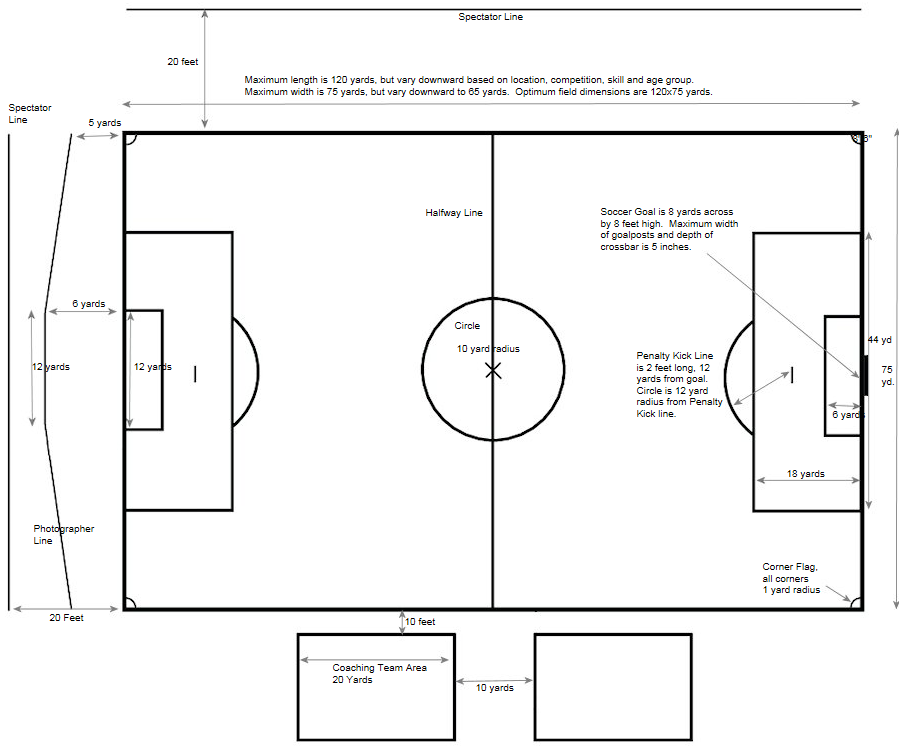Soccer Field Dimensions
Soccer Field Dimensions & Measurements
The Basic Soccer Field
Quick Facts About Soccer Field Measurements
What is the length and width of a soccer field?
It varies, but the optimum width is 75 yards and the optimum length is 120 yards. The widths can vary between 65 and 80 yards while the lengths vary between 110 and 120 yards.
How wide is the soccer goal?
8 yards or 24 feet.
How tall is a soccer goal?
8 feet tall
What are those corner circles areas called?
Corner kicks.
How tall should a soccer flag be?
5 feet.
The Beautiful Game: A Global History of Soccer
For most Americans, “football” conjures images of gridiron giants and strategic huddles. But across the vast expanse of the globe, the word ignites a different passion – the beautiful game of soccer, or association football as it’s formally known. Played by an estimated 250 million people in over 200 countries, soccer reigns supreme as the most popular sport on the planet. Its rich history and global appeal paint a fascinating picture of human ingenuity and the unifying power of sport.
Soccer’s roots trace surprisingly far back. The Han Dynasty in China (206 BC – 220 AD) nurtured a competitive game called cuju. Players used any body part except their hands to propel a ball through a net, making it an early ancestor of today’s goals. Even the ancient Greeks and Romans enjoyed similar games around the same time period, showcasing the universal appeal of kicking a ball around for some friendly competition.
The foundation of modern soccer, however, is laid in 19th century England. Public schools across the country reveled in various forms of football, each with slightly different rules. In 1848, Cambridge University introduced the highly influential Cambridge Rules, attempting to standardize the sport. However, achieving complete uniformity proved challenging. This quest for unified rules culminated in the formation of the International Football Association Board (IFAB) in 1886. This governing body, formed by the football associations of England, Scotland, Wales, and Ireland, continues to dictate the Laws of the Game.
Shortly after, in 1904, FIFA, the sport’s international governing body, emerged on the scene. Interestingly, FIFA pledged to uphold the very Laws of the Game established by the Football Association, solidifying their international legitimacy.
The beautiful game boasts a rich tapestry of competitions. The FA Cup, established in 1872, holds the distinction of being the world’s oldest football competition. English teams continue to battle it out for this prestigious trophy. But the pinnacle of international competition undoubtedly rests with the FIFA World Cup. Held every four years, the World Cup ignites a global frenzy. Hundreds of national teams participate in qualifying rounds, with the crème de la crème, 32 teams, ultimately vying for glory in a month-long spectacle.
Soccer’s reach extends far beyond international tournaments. Professional leagues captivate audiences across Europe, South America, and increasingly, in the United States. The inclusion of soccer in the Olympic Games since 1900 further underscores its global significance.
The beautiful game’s popularity isn’t merely a reflection of its historical depth or international presence. Soccer’s simplicity and accessibility are key ingredients in its widespread appeal. Requiring minimal equipment – a ball and a playing surface – soccer allows anyone, anywhere to participate. This inherent inclusivity fosters a sense of community and camaraderie, transcending cultural and social barriers.
In the United States alone, millions of youngsters lace up their cleats and chase dreams of glory on the soccer field. Combine this with the passionate supporters filling stadiums worldwide and the millions glued to screens for televised matches, and it becomes undeniably clear why soccer reigns supreme as the world’s most popular sport. It’s a testament to the unifying power of a simple game, where passion, skill, and a touch of magic come together to create the beautiful game.

